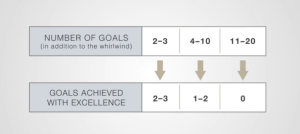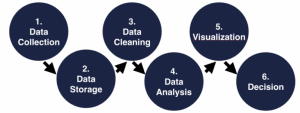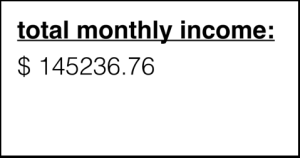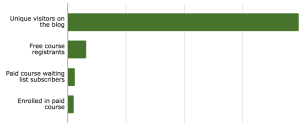Apr 23, 2019
How to find your most important marketing metric: a step-by-step guide
By Supermetrics
[ Updated Feb 17, 2023 ]
10-MINUTE READ · By Tomi Mester
Every second business I start to work with on data projects produces one very common symptom: they try to focus on too many things at the same time.
Just recently, I asked a friend of mine who runs an e-commerce company of 11 people, “What’s the most important metric that you’re currently focusing on?” The answer was, “Oh, actually, we have 9.”
What? That’s too many!
Then he added, “and we have a hard time following up with them all.”
Well, I figured.
For a small or medium online business, it’s almost impossible to focus on more than one main metric at the same time. Targeting and improving one key number is simple and actionable. Adding one or two more makes things more complex. But having 9 metrics to act on… that leads to total confusion.
That’s why you have to figure out your single most important marketing metric. In this article, I’ll show you how.
The science behind your most important marketing metric
The authors of the book The 4 Disciplines of Execution put a lot of energy and work into researching this topic and they found this:

If a team has 2-3 goals, they can often achieve 2-3 of these with excellence. Great! If the team grows this number to 4-10, the outcome will actually be worse. Only 1 or 2 goals will be reached. And when they go further and set 11-20 goals, in most cases, none of these will be achieved…
By the way, this is nothing new. In economics, this phenomenon is called the law of diminishing returns and you can discover it many times in life.
And if you think about it, for small businesses – where focus plays a key role – it’s very logical that it applies, too.
What’s not your most important metric
In the article Data Science for Business, I described the six steps of a typical data science project.

Without any doubt, from a business perspective, the most important step is the decision part.
Whatever data you collect, whatever data analyses you run and however you visualize it, usually you have one end goal: making better, more educated decisions. And because of that, every data project should be started considering this last, sixth step: figuring out what kind of decisions you want to support with your data. It’s a really complex topic but it comes down to one question: what are your current business goals?
Once you know that, you will know the decisions you want to make and you will know the key metrics you will have to look at.
Here, I’ll give you two methods that will help you to figure out your most important metric. But first, let me clarify one common misunderstanding…
Revenue is (usually) not your most important metric.
At really bad companies the leadership dashboard looks like this:

They set and target one single metric: revenue.
I won’t go into the moral problems of this mindset, but I will approach it from a data science standpoint, instead. Having revenue as your most important number is usually very problematic because of these three things:
- You can’t have a direct impact on it. Revenue is a result of multiple processes at your company, so you’ll only have an indirect impact on it.
- It’s a lagging metric. Just like losing weight when you exercise, making money is a long-term outcome of your efforts.
- Revenue is not actionable. You need a number that you can act on.
Don’t get me wrong, revenue is important – but in most cases, it’s not the number you should focus on. You should find a metric that drives revenue, but is more immediate and more actionable. Here are two ways how to find your most important metric.
How to find your most important metric
Method 1: Use Common Sense
It’s always easier to find your key metric when you have some initial data to rely on. If you can find strong correlation between, let’s say, the onboarding experience of your users and your revenue, well, that’s half the battle already. Whether you have this advantage or not, use common sense.
Try to answer these two questions first:
- What phase is your business in?
- What type of business do you have?
Let me explain.
1. What phase is your business in?
If you recently founded a startup and just launched a new product but only have 10 visitors a day to your website then your target will be to turn that daily visitor number from 10 to 1000. Once you reach that goal you can start looking at something related to engagement and think how you can improve your conversion rates. From there you can look at something closer to sales, like qualified leads.
This is just a simple example with dummy numbers but I hope it helps explain the idea: the phase of your business affects what you pick for your most important metric.
Note, this also demonstrates an important principle: from time to time, you can (and will) change your most important metric.
2. The other question is: What type of business do you have?
Just think of the many different business types you encounter online:
- ecommerce businesses (like Zappos)
- online education platforms (like Ramit Sethi)
- Software as a Service providers (like Supermetrics)
- streaming services (like Spotify)
- B2B businesses and agencies (like Hanapin Marketing)
- and so many more…
Different business types should focus on different metrics:
- For a streaming service like Spotify the total listening time is a good target. It tells them about the stickiness of their product, but it’s also a good predictor of the number of premium subscribers.
- For Zappos, number of returning customers could be interesting. It’s strongly correlated to revenue but it also shows the satisfaction of the customers (they won’t come back if they had a bad experience before).
- For Ramit Sethi (he creates online courses about how to start an online business), it could be a good idea to follow how many students actually started a successful online business. It measures the quality of Ramit’s courses but it’s also a good early predictor for possible student referrals.
- For a marketing agency, the number of monthly qualified leads could be a useful metric, since it’s easy to measure and it usually has a strong impact on revenue.
As I have said, at this point, you will work based on common sense. Don’t worry, it’s temporary. You can change your key metric later – when you have more data that shows you better what number should be the focus of your interest.
Method 2: Take a look at your funnel
Everything’s easier when you have data and you start to analyze it. What I particularly recommend is setting up a funnel that shows your customer journey from the first touch point until sales. For example, here’s my funnel at Data36 (my business sells online courses):

(Note: I changed the exact numbers so it’s easier to understand what I want to say here. In reality, my visitor-to-free-course conversion rate is much lower than on the picture: around 0.2%.)
Once you have your funnel set up, you will see much more clearly the most problematic part of your business and where is your biggest potential to grow. For instance, it’s quite clear that for me the current focus should be (and it is in fact) to turn my readers into free course registrants. The more mature your business is, and the more problems you fix, the further down you can focus in your funnel.
So looking at your funnel is another simple, useful and data-driven way to figure out your current most important metric.
Finding Your Most Important Metric: A checklist
After starting the thinking process, you will have a few great candidates for your most important metric. Here is a checklist that will help you quickly eliminate the bad ones. Go through and see if the metric you came up with fulfils these conditions:
- It gives good feedback on your users’ success: You are in business to serve your users. If you don’t do that, they won’t use your product – and they won’t pay you, either. So your number should reflect their success.
- It drives revenue: You need to ensure that your current efforts support your later revenue goals, too.
- It’s actionable: When you look at your number, would you act differently if it showed X (a very big number) or Y (a very low number)? If not, then you are not looking at the right metric.
- It’s measurable: A good metric is something that you can apply the following sentence to: “It’s __ now; I want to improve it by __% by ____ (date).”
- You have a significant number of data points: For example, if you have 1 or 2 newsletter subscribers a day, then number of subscribers is not the perfect key metric for you. Imagine that you want to run an A/B test to improve your newsletter subscription rate. Collecting a statistically significant amount of data would take literally years.
- It’s not a lagging metric: Here’s an example. With SaaS products, it’s pretty common to offer a 30-day trial period before asking for payment. In those cases the trial-to-paid conversion is not a good number to look at because there is a 30-day window before you see an actual conversion happening. That’s too slow. If you are in this situation, you should find another more immediate number to look at. For example, for SaaS businesses it could be very likely that users who discover and use all key features of the service in the first one or two days of their trial are much more likely to convert to paying users on the 30th day than those who don’t.
These are other conditions that can be useful, but as a starting point if you’re able to fulfil these six, you can be confident you have found a strong most important metric!
How to use your most important metric the right way
Let’s talk about how you will take advantage of your most important metric.
The first and most self-evident action is reporting. Finally, you can create focused and actionable reports!
Let’s say that you figured out that onboarding is your main target. Let’s define who counts as an onboarded user and get your numbers. The easiest way to visualize it is to go to Google Data Studio and create a trend chart and a scorecard for it. For instance:

You can follow up with this number daily or weekly – it’s up to you. But now you can see clearly if you are heading in the right direction. If you do not reach your target numbers, you can ask yourself: did you do everything to achieve your goals? Can you do something better? For example, in this case did you spend enough on marketing? Did you bring in high quality users? Is your onboarding process user-friendly?
If you want to go further, you can break this number down with further analyses:
- You can analyze segments
- You can examine the previous funnel steps
- You can run A/B tests focusing on improving this number
Most Important Metric FAQs
There are a few common questions that I get all the time. Let me address these here:
FAQ #1 – “Can I have more than one most important metric?”
For really small companies (1-50 employees) I strongly advise against having more than one focus metric. When you get bigger, it can get trickier to have only one. In this case, you might have two, but definitely not more. At mid-size and bigger companies (300+ people) this rule changes. In these cases, every department will have its focus metric that supports the company’s overall goal.
FAQ #2 – “How can I describe my whole company with only one number?”
You shouldn’t. The concept of having one number is not about struggling to stuff everything into one single number (it’s not possible anyway). It’s about finding the right focus at the given phase of your business. For example, if you have enough visitors on your website and you are not worried about that anymore, you can still monitor that number but your focus metric won’t have to represent it any more.
FAQ #3 – “Can it change over time?”
Yes. And it will.
As I described, your most important metric also depends on which phase your business is in. So it’s natural that as your business develops, you have to change your key metric, too. I recommend following up and reconsidering your most important metric every quarter.
Conclusion
Finding your most important metric is about finding your focus.
Once you have it, not only will your data science projects and marketing be much more impactful, but your whole decision making process will become simpler, better, and faster. Having one clear common goal will also force different teams to be more aligned.
When everyone works for the same most important goal, everyone will go together.
And there’s nothing more powerful than that for a business.
About Tomi Mester
Tomi Mester is a data analyst and researcher. He has worked for Prezi, iZettle and several smaller companies as an analyst/consultant. He’s the author of the Data36 blog, where he writes posts and tutorials on a weekly basis about data science, AB-testing, online research and data coding. Plus, he creates video courses about coding and data strategy. He’s an O’Reilly author and presenter at TEDxYouth, Barcelona E-commerce Summit and Data Conference.
Turn your marketing data into opportunity
We streamline your marketing data so you can focus on the insights.